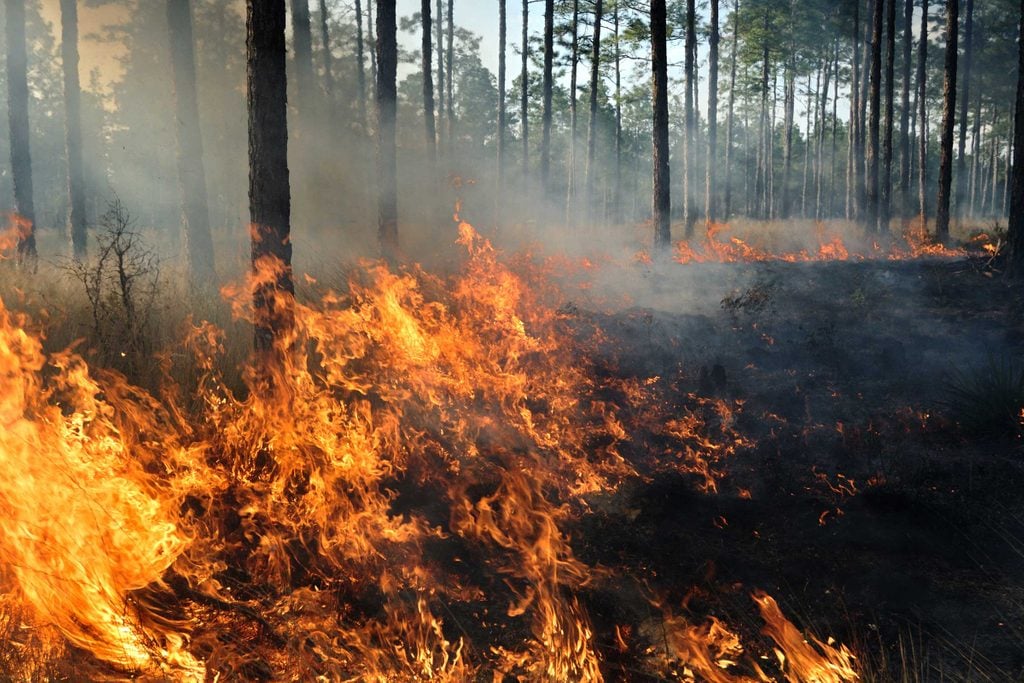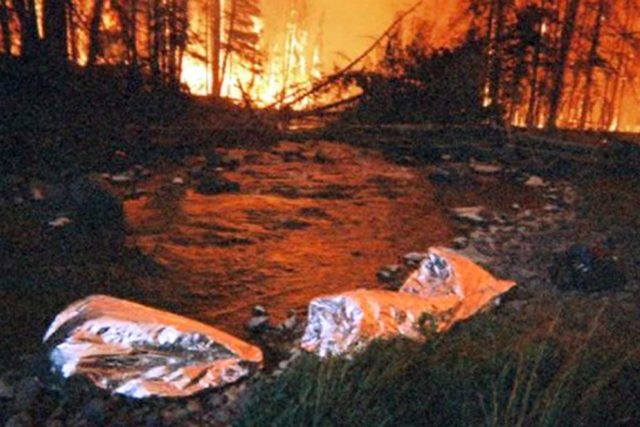What It Feels Like to Have a Wildfire Burn Over You, Straight from a Firefighter
Updated: Nov. 28, 2022

The most dangerous time for a wildfire is late afternoon, when the sun is hot, relative humidity is low, and winds are high. It's called the witching hour.
America’s deadliest wildfire in recent years started off as a small brush fire, ignited by a lightning strike. It occurred on June 28, 2013, outside of Yarnell, Arizona, population 543. Within hours, it grew from a manageable fire into a raging, unpredictable inferno, trapping a team known as the Granite Mountain Hotshots, 19 men and women trained to fight forest fires. As the blaze changed direction with unexpected ferocity, the crew members had one chance for survival: lying facedown on the ground, covering themselves with thin aluminum fire shelters, and letting the fire burn over them. Some made it into their shelters, but it didn’t matter; the speed and intensity of the fire were too much, and all 19 were killed.
Fire shelters are a last resort. They’re made of an outer layer of aluminum foil, backed by a silica weave that reflects heat. When deployed, they are shaped like large cocoons, in part to trap breathable air inside. If you have to use one, chances are you’re already in trouble. But fire shelters have saved the lives of hundreds of people and spared hundreds of others from serious burns. Unfortunately, they are also increasingly in demand. Tens of thousands of wildfires crop up each year across the United States, mostly out in the West. Small firefighting crews will easily extinguish the majority. But, as in Yarnell, even minor brush fires can quickly turn into deadly conflagrations.
Lathan Johnson knows all too well how to outmaneuver a wildfire. He is a Colorado firefighter who survived a shelter deployment during the Little Venus Fire, which burned deep in the backcountry of Wyoming’s Shoshone National Forest in July 2006.
“You’re not always going to be able to outsmart a fire,” Johnson said. “I thought for sure I’d never have to use a fire shelter, and then one day I found myself shaking out one.”
It happened when Johnson was overseeing a group assigned to relieve another crew that was monitoring the fire several miles up a river valley. Johnson’s crew got a late start and didn’t arrive at their destination until the afternoon, the most dangerous time for a wildfire, when the sun is hot, relative humidity is low, and the winds are high. “That’s when bad things happen on a fire,” Johnson says. “We call it the witching hour.”
In fact, the Wildfire Lessons Learned Center in Tucson, Arizona, studied 115 instances of firefighters trapped by wildfires over the past 20 years and found that half occurred between 2 and 5 p.m. and all but 12 happened between noon and 6 p.m.
Johnson also knew a weather front would pass through sometime in the afternoon, which usually means a shift in wind direction. But spotty radio communication deep in the valley kept him from grasping the change in fire activity until he turned a corner on the trail and saw a massive plume of black smoke several hundred yards up the canyon. The fire was coming for him and his crew, tearing through stands of bug-killed trees.
A firefighter who’d survived under his shelter took this shot of the Little Venus Fire.
Johnson did a quick head count and came up one short. He hadn’t noticed that one of his firefighters had panicked and split off from the group a few minutes earlier. They didn’t have time to look for her—they couldn’t outrun the fire, and if they waited any longer to deploy, they might not have enough time to get under their shelters before the wall of flame washed over them. Between them and the fire was a 30-foot rock face, which would give some protection from the heat and flame.

“We’re going to deploy here,” Johnson told the crew. For a moment, he saw their fear and disbelief. But then they set to work, reverting to procedures that they knew well from annual training exercises. Offering the illusion of control, the familiar routine seemed to calm them: Unzip the carrying case, pull out the shelter, and shake it open. Step into it, pull it over your head, and lie down with your face close to the ground, where the air is cleanest and coolest. Use your elbows, knees, and feet to pin the shelter down to counteract winds created by the fire, which might top 60 mph. These proven skills will help you survive any life emergency.
A minute or so after Johnson worked himself into his shelter, the first wave of heat and flame and noise swept over him. It lasted about five minutes. The shelters did their jobs well, deflecting most of the fire’s radiant heat. He and the others left their shelters to put out some spot fires and to burn other areas of brush to better protect themselves. Another wave of fire was coming, and they knew it would last much longer than the first. They covered themselves once more. Embers and chunks of debris rained down on Johnson’s shelter. From inside, he tried to knock them off while constantly shifting his weight to keep his shelter edges pinned down. He heard nearby trees burst into flame with a whoosh. He tried to peek out of the shelter, but smoke and hot air poured in. He thought about his missing crew member. How would he explain to her parents that he had let their daughter die?
The firefighters had packed close together, which reduced their overall exposure to heat and put them near enough to talk over the roar of the fire. They tried calming a frantic crew member who wanted to flee, convinced he’d burn to death and would be better off trying to outrun the flames—or just getting the inevitable over with more quickly.
In the dude fire, one firefighter called out, “I can’t take it anymore.” he then broke out of his shelter and died.
This has happened before, many times. In the midst of a burnover that lasted for 15 minutes in the 1990 Dude Fire near Payson, Arizona, firefighter Curtis Springfield called out to his colleagues, “I can’t take it anymore.” He then broke out of his shelter, sucked hot air into his lungs, and died. The Dude Fire killed five other firefighters who left their shelters or hadn’t fully deployed them. Four firefighters who stayed under their shelters during the burnover survived, most with minor burns.
During the Little Venus Fire, after the flames passed through Johnson’s deployment site along the creek, the heat ebbed and the smoke cleared. Forty-five minutes after the second wave of fire hit them, the nine firefighters emerged from the shelters relatively unscathed, with only a few minor burns. (This is what it feels like to be caught in a California fire.)
The missing firefighter had actually deployed her shelter in a rocky stream bed, and although she had faced a more intense wall of flame, she was unhurt. Next, read up on these things all firefighters wish you knew.